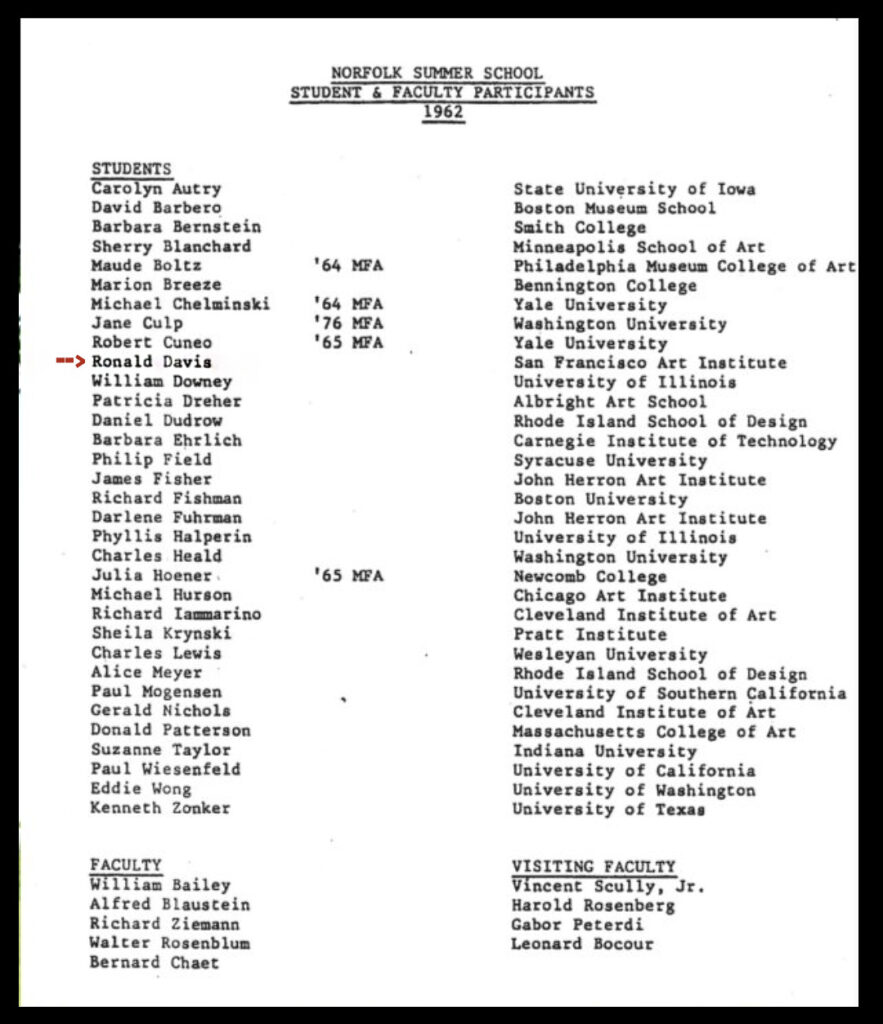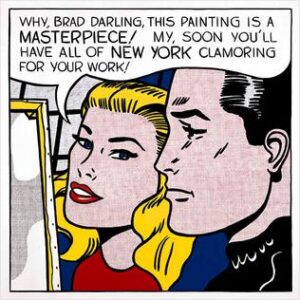Continued from Part 3:
I drove east in 1962, having been invited to the Norfolk Yale School of Music and Art as a grantee. The crits I got there were incomprehensible. After a while I figured out they were analyzing my paintings in terms of Cubism, and Cubism was something I was not looking for. I didn’t want to look at the world and then abstract it. I said I wanted to approach it more directly, just make abstract paintings – which resulted in a couple of heated discussions. Phillip Guston came up to Norfolk and sat on the lawn and talked about himself for five hours. He said, “You have to paint flat-footed, not looking at your painting while you’re painting it.” Good advice indeed!
 While I was back east I expected to be able to view the works of Pollock, Still, De Kooning, Rothko, et al. But what I did find in the museums and New York galleries were some gray boxes and some blown-up versions of panels from comic books. I was taken aback because these were not the serious, even elitist pictures I had been seeking to emulate and learn how to make. They amused me, particularly a Lichtenstein, where the viewer is looking through a keyhole at a couple, with the bubble caption: “I just looked, Brad, and there’s nobody out there.” It was reassuring to find out that I was the “nobody,” and interesting to find in these formative years that art had become entertainment rather than a means of expression. It was liberating to discover that art didn’t have to express anything or mean anything. That it didn’t matter what a painting looked like.
While I was back east I expected to be able to view the works of Pollock, Still, De Kooning, Rothko, et al. But what I did find in the museums and New York galleries were some gray boxes and some blown-up versions of panels from comic books. I was taken aback because these were not the serious, even elitist pictures I had been seeking to emulate and learn how to make. They amused me, particularly a Lichtenstein, where the viewer is looking through a keyhole at a couple, with the bubble caption: “I just looked, Brad, and there’s nobody out there.” It was reassuring to find out that I was the “nobody,” and interesting to find in these formative years that art had become entertainment rather than a means of expression. It was liberating to discover that art didn’t have to express anything or mean anything. That it didn’t matter what a painting looked like.
 Struggling to gain a finger hold in the formidable tradition of abstract painting, I attempted synthesis between “the Minimal Object,” Pop and Op fashion, and traditional, emotion-driven expressionist painting. For instance, even though I, like DuChamp, reintroduced linear perspective illusion – and the illusions of objects – into my painting, the objects themselves remained abstract and non-referential, although that’s usually up to the surrealist viewer.
Struggling to gain a finger hold in the formidable tradition of abstract painting, I attempted synthesis between “the Minimal Object,” Pop and Op fashion, and traditional, emotion-driven expressionist painting. For instance, even though I, like DuChamp, reintroduced linear perspective illusion – and the illusions of objects – into my painting, the objects themselves remained abstract and non-referential, although that’s usually up to the surrealist viewer.
This struggle between object and the pictorial remains central to my work after forty years. I did not bring ironic non-art objects or concepts into the context of art at a time when trendy non-art was being redefined as “art.” It’s my belief that art as art has become devalued.
